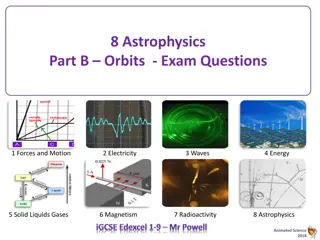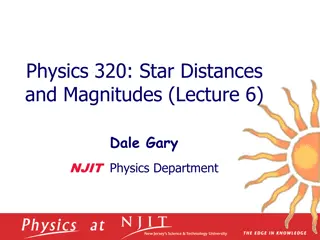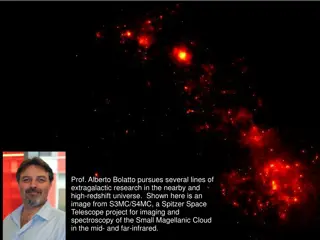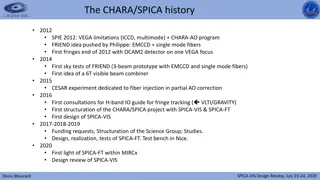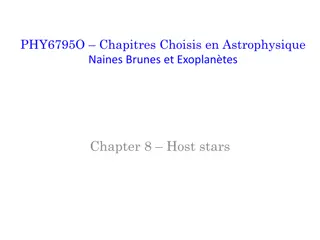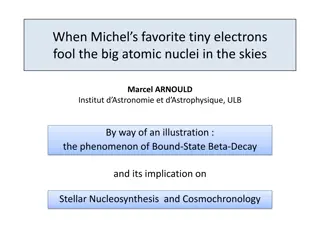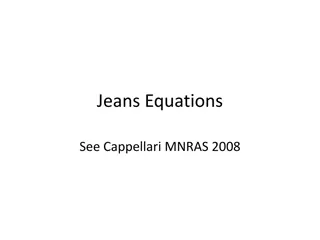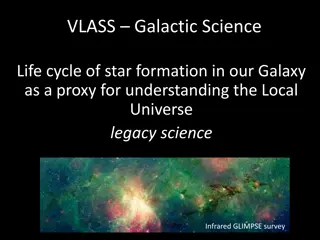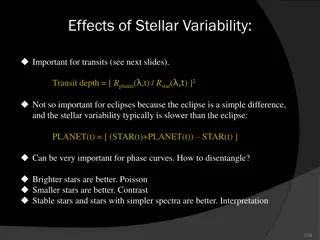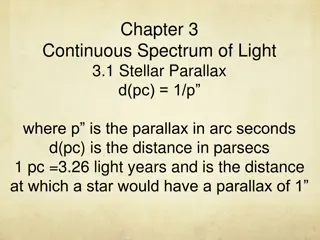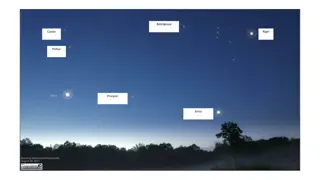Understanding Stellar Structure in Fundamental Astrophysics
Exploring the intriguing world of stellar structure and energy production in stars. Discover the equilibrium of forces, hydrostatic equilibrium, energy transport mechanisms, boundary conditions, equations of state, and nuclear reactions shaping the dynamics of stars. Unveil the mysteries behind the generation of stellar energy and the origin of heavier elements within stellar interiors.
Download Presentation

Please find below an Image/Link to download the presentation.
The content on the website is provided AS IS for your information and personal use only. It may not be sold, licensed, or shared on other websites without obtaining consent from the author. Download presentation by click this link. If you encounter any issues during the download, it is possible that the publisher has removed the file from their server.
E N D
Presentation Transcript
Stellar Structure Fundamental Astrophysics
Stars A star is a giant gas ball at very high temperature. The stellar energy is generated in its interior. Th pressure produced by the energy released in the inner regions pushes the gas outwards. Gravity pulls gas towards the centre. Let s calculate the equations goverging this equilibrium of forces: 2 30/08/2024 16:01
Hydrostatic equilibrium 3 30/08/2024 16:01
Equation of continuity 4 30/08/2024 16:01
Conservation of energy 5 30/08/2024 16:01
Temperature gradient - Energy transport Energy transport can take place by conduction, radiation or convection. Conduction es usually negligible. Pure radiation: Convection: 6 30/08/2024 16:01
Boundary conditions At the star s centre: M(0)=0 L(0)=0 T(0)=Tc At the surface: M(R)=M L(R)=L T(R)=0 P(0)=P0 (0)= 0 P(R)=0 (R)=0 7 30/08/2024 16:01
Equation of state Gas pressure: Radiation pressure: 8 30/08/2024 16:01
Equation of state for a degenerate gas Non relativistic (107 kg/m3) Relativistic (109 kg/m3) 9 30/08/2024 16:01
Energy production in stars Gravitational contraction was originally proposed as the energy source It would not last enough at the necessary rate. Earl universe was composed mostly of H, some He, and traces of light elements (Li, Be, ). Heavier elements originate in stellar interiors Thermonuclear fusion. 10 30/08/2024 16:01
Binding energy 11 30/08/2024 16:01
Nuclear reactions inside stars The mass of a He atom is 0.7% smaller than the mass of four H atoms Energy production is roughly per kg of H. In 1938 Hans Bethe proposed the CNO chain as the main energy source within stars. There are also other reactions 30/08/2024 16:01 12
p-p reaction It is the dominant mechanism of energy production for temperatures below 20 millon K. The first reaction is very improbable, with a characteristic time of 1010 years for the conditions in the sun. 13 30/08/2024 16:01
CON Cycle Between 20 and 100 mill. K, the dominant reaction is the CNO cycle proposed by Bethe y Weizsacker. C, N y O appear as catalysts in the reaction. Formation of 15O is the slowest reaction (t~1 mill years) and controls the rate of the whole reaction. It is energetically less efficient tha the p-p chain. 14 30/08/2024 16:01
Triple-alpha reaction As hydrogen burns, the amount of helium increases. Over 100 mill K, hellium can also fuse to produce 12C. At even higher temperature, other reactions are also possible producing elements as heavy as Fe o Ni. 15 30/08/2024 16:01
Other reactions Alpha reactions C fusion (T~5-8 108 K) 16 30/08/2024 16:01
Other reactions (II) O fusion (T~109 K) Si fusion Elementos heavier than Fe are usually generated by neutron captures in endoenergetic reactions ocurring during SN explosions. 17 30/08/2024 16:01
The sun 18 30/08/2024 16:01
19 30/08/2024 16:01
20 30/08/2024 16:01
Suns Surface Photosphere: The visible part of Sun (we cannot see the interior, because it is optically thick) It is 300-500 km thick Temperature of 8000 to 4500 K (decerasing outwards) Continuum and absorption lines (Why absorption and not emission lines?) Granulation in the surface indicates convection zones (size of ~1000 km) . Convection is necessary because radiative transport is not enough. 21 30/08/2024 16:01
Granulation at the surface of the sun,and a sunspot Typical size of granulation: 1000 km 22 30/08/2024 16:01
Limb darkening Cause: Limbs are darker (and redder) because we only see an upper (colder) shell Sun at visible wavelengths 23 30/08/2024 16:01
Suns Atmosphere Cromosphere: Above the photosphere, some 500 - 2000 km thick Temperature of 4500 to 7000 K Cannot see its continuum emission because it is much dimmer than photosphere in the background (it is much lower density). Produces emission lines (H, He and metals). Strongest line is H . 24 30/08/2024 16:01
Cromosphere observed during a total eclipse (thin red and white region) Cromosphere and Corona (seeing during a solar eclipse) 25 30/08/2024 16:01
Cromosphere in Halpha We see the cromosphere in emission (H from the photosphere is in absorption) Ondulations 26 30/08/2024 16:01
Spiculae in the cromosphere: Gas filaments ascending some 10000 km lasting serveral minutes 27 30/08/2024 16:01
The Corona Corona: Temperatures of a few million degrees (heated by magnetic fields and sound waves the details of the mechanism still not fully understood) Emits in X-rays Emission lines of very high excitaion, originated in the outer region: Coronal lines. Unknown origin until 1941, they where thought as coming from new chemical elements!!. Gas in the corona is being pushed towards interplanetary space, forming the solar wind. Sun loses some 10-13 solar mass per year in this wind. Solar wind at the surface of Earth has 5-10 part/cm3 and speeds of 500km/s. 28 30/08/2024 16:01
Corona during a solar eclipse 29 30/08/2024 16:01
Protuberancias solares 30 30/08/2024 16:01
Solar flares: They can last from seconds to nearly an hour. Magnetic energy is suddenly and violently released 31 30/08/2024 16:01
Solar activity Sunspots 32 30/08/2024 16:01
Sunspots: Known for over 400 years, Galileo already observed them. Two different regions: Umbra, surrounded by Penumbra Lower temperature (some 1500 K) than surroundings Diameter: some 10000 km Duration: days to months (even longer!) Number of spots follows a cycle with period of between 7 to 17 years (average of 11 years) High magnetic field up to 0.45 Tesla (aprox. 10000 stronger than earth s mag. Field!!) 33 30/08/2024 16:01
Sunspot cycle known since a long time !! 34 30/08/2024 16:01
Magnetic fields involved in sunspots: regions where magnetic files come out of the surface. Hot gas cannot reach the surface Lower temperature Spots come in pairs with opposite polarity. 30/08/2024 16:01 36
Loops: Ionized gas moving along the magnetic field Prominences can be: Quiet Loop (figure) Eruptive 37 30/08/2024 16:01
Rotacin diferencial del Sol (descubierto en 1630 por Christoph Schneider) 38 30/08/2024 16:01
Top: Variation in sunspot distribution related to diferential rotation. Bottom: Evolution of number of sunspots 39 30/08/2024 16:01
Creacin del campo magntico a travs del efecto dinamo Necesario: Medio conductor, rotaci n diferencial Actividad solar m ximo cuando enredo de las l neas del campo magn tico es m ximo Detalles del proceso son complejos. 30/08/2024 16:01 40
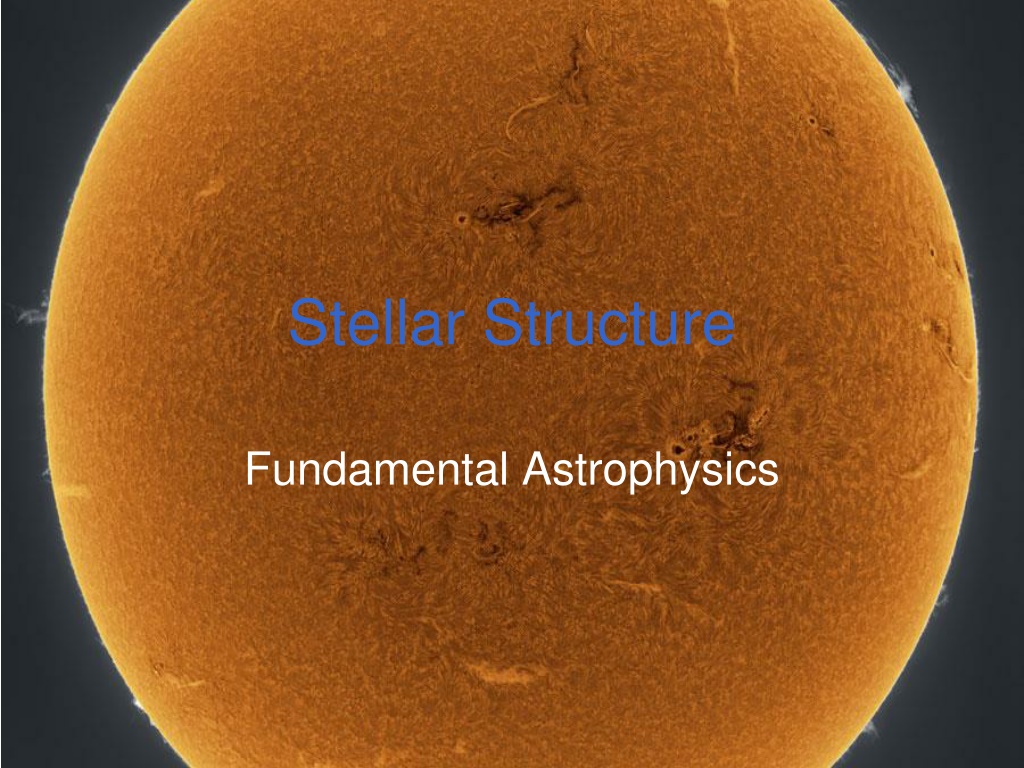

![[PDF⚡READ❤ONLINE] Black Hole Astrophysics: The Engine Paradigm (Springer Praxis](/thumb/21503/pdf-read-online-black-hole-astrophysics-the-engine-paradigm-springer-praxis.jpg)
![[PDF⚡READ❤ONLINE] Cosmology and Particle Astrophysics (Wiley-Praxis Series in As](/thumb/21627/pdf-read-online-cosmology-and-particle-astrophysics-wiley-praxis-series-in-as.jpg)


